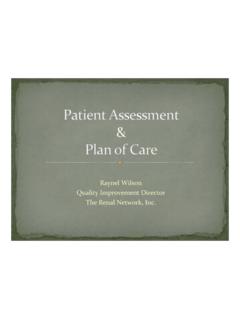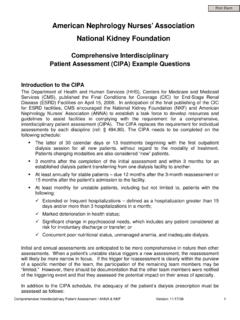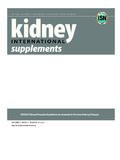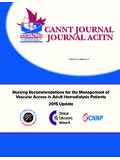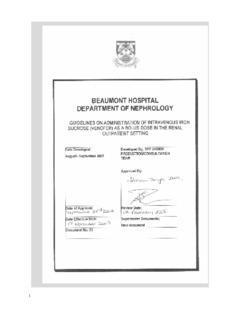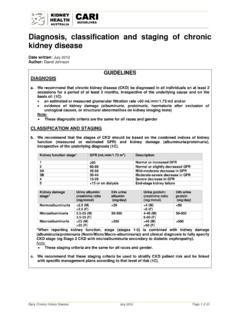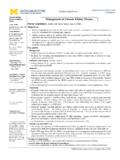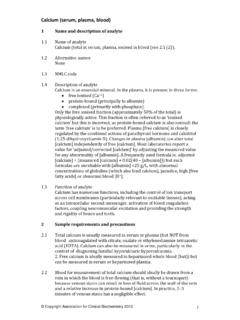Transcription of KDOQI CLINICAL PRACTICE GUIDELINE AND …
1 KDOQI CLINICAL PRACTICE GUIDELINE AND CLINICAL PRACTICE RECOMMENDATIONS FOR ANEMIA IN chronic KIDNEY DISEASE: 2007 UPDATE OF HEMOGLOBIN TARGET NOTICE SECTION I: USE OF THE CLINICAL PRACTICE GUIDELINE AND CLINICAL PRACTICE RECOMMENDATIONS The CLINICAL PRACTICE GUIDELINE (CPG) and CLINICAL PRACTICE Recommendations (CPRs) are designed to provide information and assist decision-making. They are not intended to define a standard of care, and should not be construed as one. Neither should they be interpreted as prescribing an exclusive course of management. Variations in PRACTICE will inevitably and appropriately occur when clinicians take into account the needs of individual patients, available resources, and limitations unique to an institution or type of PRACTICE .
2 Every health-care professional making use of the CPG and CPRs is responsible for evaluating the appropriateness of applying them in the setting of any particular CLINICAL situation. SECTION II: CONFLICTS OF INTEREST DISCLOSURE The National Kidney Foundation (NKF) makes every effort to avoid any actual or potential conflicts of interest that may arise as a result of an outside relationship or a personal, professional, or business interest of a member of the Work Group. Specifically, all members of the Work Group are required to complete, sign, and submit a Conflict of Interest: Disclosure and Attestation form showing all such relationships that might be perceived as real or potential conflicts of interest.
3 All affiliations are published in their entirety at the end of this document in the Work Group members biographical sketch and are on file at the NKF. 2 WORK GROUP MEMBERSHIP Work Group Co-Chairs David B. Van Wyck, MD Kai-Uwe Eckardt, MD University of Arizona College of Medicine University of Erlangen-Nuremberg Tucson, AZ Erlangen, Germany Work Group John W. Adamson, MD Patricia Bargo McCarley, RN, MSN, NP Blood Center of SE Wisconsin Diablo Nephrology Medical Group Blood Research Institute Walnut Creek, CA Milwaukee, WI Allen R. Nissenson, MD Jeffrey S. Berns, MD UCLA Medical Center University of Pennsylvania School of Medicine Los Angeles, CA Philadelphia, PA Gregorio T.
4 Obrador, MD Steven Fishbane, MD Universidad Panamericana School of Medicine Winthrop University Hospital Mexico City, Mexico Mineloa, NY John C. Stivelman, MD Robert N. Foley, MD Northwest Kidney Center Nephrology Analytical Services Seattle, WA Minneapolis, MN Colin T. White, MD Sana Ghaddar, RD, PhD British Columbia Children s Hospital American University of Beirut Vancouver, Canada Faculty of Agriculture and Food Sciences Beirut, Lebanon John S. Gill, MD, MS Liaison Members University of British Columbia Francesco Locatelli, MD St. Paul's Hospital Azienda Ospedaliera DI Lecco Vancouver, Canada Lecco, Italy Kathy Jabs, MD Iain C. Macdougall, MD Vanderbilt University Medical Center King s College Hospital Nashville, TN London, England Evidence Review Team National Kidney Foundation Center for GUIDELINE Development and Implementation at Tufts-New England Medical Center, Boston, MA Katrin Uhlig, MD, MS, Program Director Nephrology, Joseph Lau, MD, Program Director, Evidence Based Medicine Amy Earley, BS, Research Assistant 3 KDOQI ADVISORY BOARD MEMBERS Adeera Levin, MD, FACP KDOQI Chair Michael Rocco, MD, MSCE Garabed Eknoyan, MD KDOQI Co-Chair Emeritus Bryan Becker, MD Peter G.
5 Blake, MD, FRCPC, Allan J. Collins, MD, FACP Peter W. Crooks, MD William E. Haley, MD Bertrand L. Jaber, MD Cynda Ann Johnson, MD, MBA Karren King, MSW, ACSW, LCSW Michael J. Klag, MD, MPH Craig B. Langman, MD Derrick Latos, MD Linda McCann, RD, LD, CSR Ravindra L. Mehta, MD, FACP Maureen Michael, BSN, MBA William Mitch, MD KDOQI Vice-Chair Nathan Levin, MD, FACP KDOQI Co-Chair Emeritus Gregorio Obrador, MD, MPH Rulan S. Parekh, MD, MS Brian Pereira, MD, DM Neil R. Powe, MD Claudio Ronco, MD Raymond Vanholder, MD, PhD Nanette Kass Wenger, MD, MACP David Wheeler, MD, MRCP Winfred W. Williams, Jr., MD Shuin-Lin Yang, MD Ex-Officio Josephine Briggs, MD David Warnock, MD NKF- KDOQI GUIDELINE Development Staff Kerry Willis, PhD Donna Fingerhut Michael Cheung Dekeya Slaughter-Larkem 4 TABLE OF CONTENTS Work Group 3 KDOQI Advisory Board 4 List of Tables and 6 CLINICAL PRACTICE Recommendation 8 CLINICAL PRACTICE Recommendation 10 CLINICAL PRACTICE GUIDELINE 12 Appendix 1.
6 Anemia Update 19 Appendix 2. Comparison of FDA-Approved Prescribing Information for Epoetin Alfa and KDOQI Anemia 27 30 Summary and Evidence Profile 33 Work Group Members Biographical and Disclosure 57 5 TABLES Table 1. Ongoing Randomized Controlled Trials on Hemoglobin Targets in Adult Patients with CKD Identified from 33 Table 2. Summary Table of RCTs Comparing Different Hb Targets/ESA Doses on Key CLINICAL Outcomes in the HD-CKD and PD-CKD 34 Table 3. Summary Table of RCTs Comparing Different Hb Targets/ESA Doses on Quality of Life in the HD-CKD and PD-CKD 36 Table 4. Summary Table of RCTs Comparing Hb Targets/ESA Doses in Non-CVD/ Mortality Adverse Event Rates in the HD-CKD and PD-CKD 39 Table 5.
7 Summary Table of RCTs Comparing Hb Targets/ESA Doses on Exercise Capacity in the HD-CKD and PD-CKD 42 Table 6. Evidence Matrix of Study Quality by Outcome for RCTs Comparing Different Hb Targets/ESA Doses in the HD-CKD and PD-CKD 43 Table 7. Evidence Profile of RCTs Comparing Different Hb Targets/ESA Doses in the HD CKD and PD-CKD 44 Table 8. Summary Table of RCTs Comparing Different Hb Targets/ESA Doses on Key CLINICAL Outcomes in the ND-CKD 47 Table 9. Summary Table of RCTs Comparing Different Hb Targets/ESA Doses on Quality of Life in the ND-CKD 50 Table 10. Summary Table of RCTs Comparing Hb Targets/ESA Doses in Non-CVD/Mortality Adverse Event Rates in the ND-CKD 52 Table 11.
8 Evidence Matrix of Study Quality by Outcome for RCTs Comparing Different Hb Targets/ESA Doses in the ND-CKD 54 Table 12. Evidence Profile of RCTs Comparing Different Hb Targets/ESA Doses in the ND CKD 55 FIGURES Figure 1. Randomized controlled trials comparing lower with higher Hb target 11 Figure 2. Relative mortality risk for assignment to higher Hb treatment targets in patients with non-dialysis CKD (Stages 1-5).. 13 Figure 3. Relative risk of adverse cardiovascular events for assignment to higher Hb treatment target in patients with non-dialysis CKD (Stage 1-5).. 13 Figure 4. Relative mortality risk for assignment to higher Hb treatment target in CKD patients undergoing 14 Figure 5.
9 Relative risk of adverse cardiovascular events for assignment to higher Hb treatment target in CKD patients undergoing 14 6 1 CPG and CPR HEMOGLOBIN TARGET 2 3 The Hb target is the intended aim of ESA therapy for the individual CKD patient. In CLINICAL 4 PRACTICE , achieved Hb results vary considerably from the Hb target. 5 6 7 In the opinion of the work group, selection of the Hb target and selection of the Hb 8 level at which ESA therapy is initiated in the individual patient should include 9 consideration of potential benefits (including improvement in quality of life and 10 avoidance of transfusion) and potential harms (including the risk of life-threatening 11 adverse events).
10 ( CLINICAL PRACTICE RECOMMENDATION) 12 13 In the opinion of the work group, in dialysis and non-dialysis CKD patients receiving 14 ESA therapy, the selected Hb target should generally be in the range of to 15 g/dL. ( CLINICAL PRACTICE RECOMMENDATION) 16 17 In dialysis and non-dialysis CKD patients receiving ESA therapy, the Hb target should 18 not be above g/dL. ( CLINICAL PRACTICE GUIDELINE - MODERATELY STRONG 19 EVIDENCE) 20 Background 21 KDOQI CLINICAL PRACTICE guidelines and CLINICAL PRACTICE Recommendations for Anemia in 22 chronic Kidney Disease, published in May 2006, included recommendations for Hb targets that 23 were based on a systematic review and structured appraisal of Randomized Controlled Trials 24 (RCTs) comparing treatment to different Hb targets.
